| 9-1. | Joint Pain Relief |
Collagen peptides include highly functional products that have been confirmed to inhibit alkaline phosphatase (ALP) activity, which promotes joint calcification.
PATENTED
| ● | Double-blind placebo controlled randomized trial |
| ● | Age 39 - 65 |
| Patients of knee osteoarthritis middle level (grade 2-3) | |
| ● | Placebo : 12 subjects |
| Highly functional type collagen peptide : 20 subjects | |
| ● | 10 g/day, 13 weeks (91 days) |
| ● | Evaluation : WOMAC score, VAS score, X ray |
| WOMAC score : | pain score based on an objective evaluation by a doctor |
| VAS score : | patient's subjective pain score |
| Placebo : | simulated medicine |
| Double-blind : | neither the doctors nor the subjects knew who received what treatment |
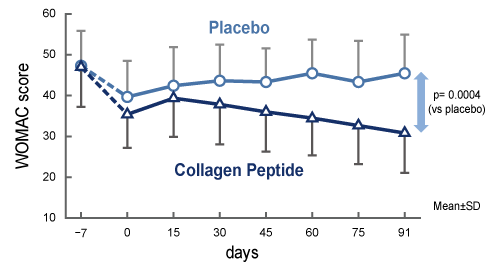
The WOMAC score is a worldwide disease-specific measure for health-related quality of life in osteoarthritis. The intake of Collapep JB improved significantly.
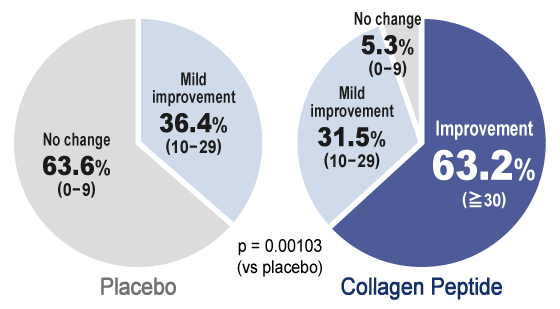
The VAS score gives an indication of the patient's own pain. The results showed that patients experienced a reduction in pain.
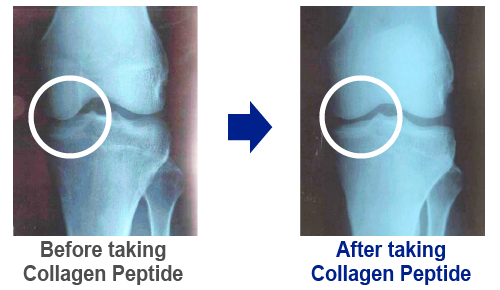
The X-ray images show less pointy bone shape, allowing for joint space generation.
Reference:Kumar et al., J Sci. Food Agric., 95_2014
| 9-2. | Joint Pain Relief case 2 |
| ● | Double-blind placebo controlled randomized trial |
| ● | Age 30 - 65 |
| Patients of knee osteoarthritis middle level (grade 2-3) | |
| ● | Placebo[Maltodextrin] : 20 subjects, 10 g/day |
| Collagen peptide[Standard type] : 21 subjects, 10 g/day | |
| Highly functional type collagen peptide[Wellnex® DI-PEPTIDE] : 23 subjects, 2.5 g/day | |
| ● | Measurement time : Baseline, Day 30, 60, 90 |
| ● | Evaluation : WOMAC score, QOL score, CTX-Ⅱ in serum, MOAK score |



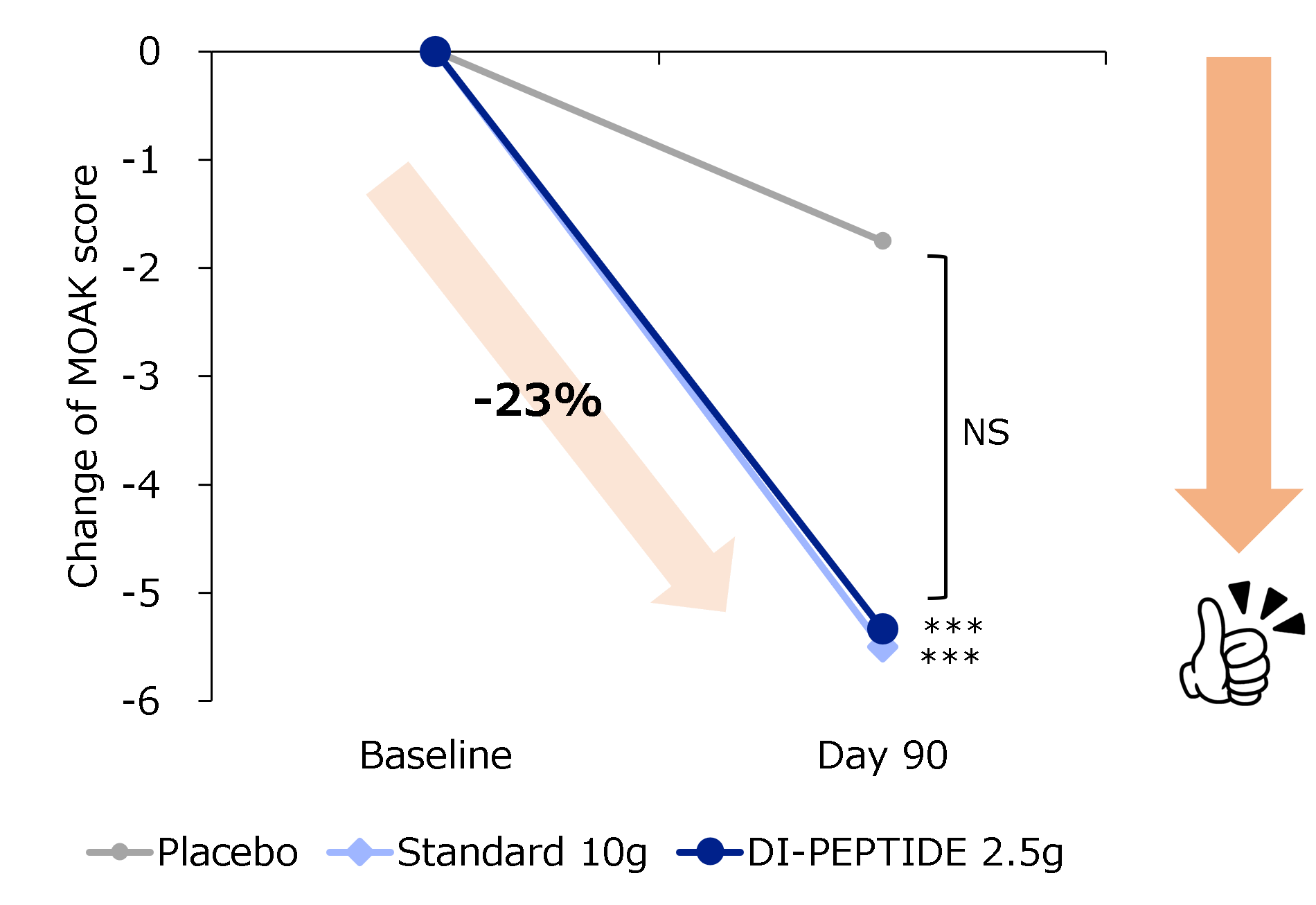
Mean, Tukey test was performed as a post-hoc test for one-way ANOVA.
### p < 0.001, VS Placebo, Paired Tukey test, *** p <0.001, VS Baseline
WOMAC = Western Ontario McMaster Universities Arthritis Index
CTX-II= C-terminal telopeptides of collagen type II
MOAK = Magnetic Resonance Imaging Osteoarthritis Knee Score
QoL = Quality of Life
Reduction(%)= (Day 90 – Baseline) / Baseline ×100
Reference:Devasia S, Joseph JT, P.S. S, et al. Management and Amelioration of Knee Joint Osteoarthritis in Adults Using a Novel High-Functional Bovine Collagen Peptide as a Nutritional Therapy: A Double-Blind, Prospective, Multicentric, Randomized, Active and Placebo Controlled, Five-Arm, Clinical Study to Evaluate the Efficacy, Safety, and Tolerability. CARTILAGE. 2024;0(0). doi:10.1177/19476035231221211
The DI-PEPTIDE group had better results than the placebo group in the WOMAC score, CTX-II level, a marker for the degradation of type II collagen in the joint, and MOAK as MRI imaging joint evaluation. Thus, the patients' QOL score improved significantly from the 30th day. Furthermore, DI-PEPTIDE results showed the almost the same with standard type collagen peptide to those obtained with a 10g intake. It represents DI-PEPTIDE can reduce the intake volume in joints management. It is believed that the active ingredients PO and OG inhibit alkaline phosphatase activity in the joints, thereby inhibiting calcification (ossification) of the joints.
| 9-3. | Improvement of joint pain in running club students |
| ● | Double-blind placebo controlled randomized trial |
| ● | Age 18 - 21, students belonging to running club |
| ● | Placebo : 21 subjects |
| Collagen peptide : 25 subjects | |
| ● | 5 g/day, 8 weeks (91 days) |
| ● | Evaluation : JKOM score, blood examination |
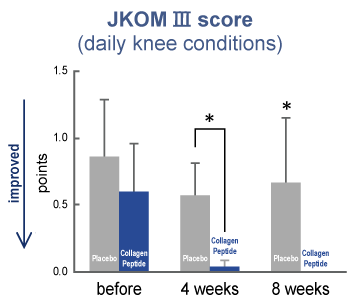
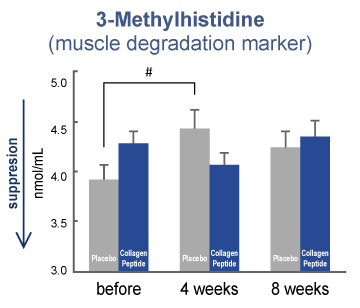
Mean ± SE, * VS Placebo, # VS Baseline
Running club students who had a heavy load on their knee joints due to training consumed 5 g of collagen peptide daily, and a significant improvement in their JKOM score (knee condition in daily life) was confirmed compared to the placebo group.
The blood level of 3-methylhistidine, a muscle degradation marker, was significantly increased in the placebo group 4 weeks after the ingestion, whereas it was not changed in the collagen peptide group. It was suggested that the intake of collagen peptide may have suppressed muscle degradation.
Reference:Kimira Y, Saito M, Kushibe S, Nomura K, Osawa Y, Sekiguchi Y, Shimizu J, Nakatani S, Koizumi S, Inoue N, Mori Y, Kobayashi J, Mano H,The effects of collagen peptide supplementation on knee joint health - a doble-blind, placebo-controlled, randomized trial in healthy university students belonging to a running club-. Japanese pharmacology and Therapeutics, 47(9), 1455-1462, 2019
Abbreviation for “Japanese Knee Osteoarthritis Measure”, which is an official evaluation method of the Japanese Orthopaedic Association.
It is scored by a questionnaire to the subjects. The questions are divided into four categories: [I] knee pain level, [II] knee pain and stiffness, [III] daily living condition, and [IV] usual activities. The lower the score, the better the knee condition.
3-Methylhistidine released into the blood is used as a muscle degradation marker as it is an end product of muscle metabolism. It is a marker that increases as the muscle is damaged and decomposes.






